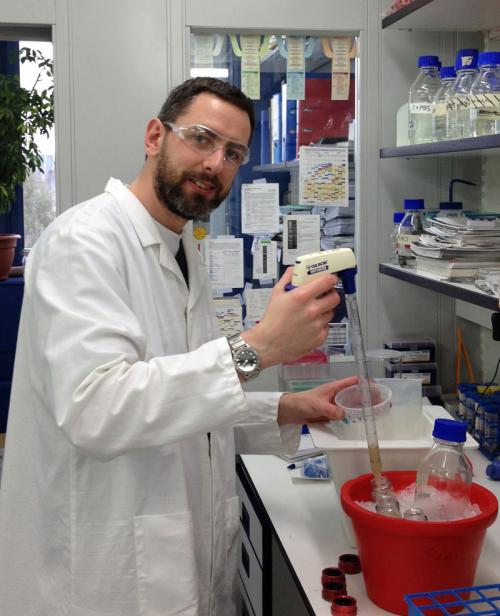
New regulatory mechanism discovered for a special class of RING-in-between-RING E3 ligases
RING-in-between-RING (RBR) enzymes are a distinct class of E3 ubiquitin ligases possessing a cluster of three zinc-binding domains that cooperate to catalyze ubiquitin transfer. The best known members of this group are PARKIN and HOIP, defects in which are associated with neuronal degenerative disease and innate immune deficiency respectively. Intriguingly, all RBR E3s investigated to date are auto-inhibited for ubiquitylation. Elucidating the mechanisms of their activation and regulation is currently an area of intense investigation.
Now work performed by Ian Kelsall in Arno Alpi's lab has revealed an unexpected mechanism for activating RBR E3s. Ian found that RBR E3s of the Ariadne subfamily, TRIAD1 and HHARI, interacted with distinct members of the cullin-RING ligase family of E3 ubiquitin ligases. Moreover, these interactions triggered the E3 ligase activity of the Ariadne E3s. Structural studies carried out by David Duda and Jennifer Olszewski from the laboratory of Brenda Schulman in St. Jude Children's Research Hospital, (Memphis, US) revealed that HHARI possesses an auto-inhibitory 'Ariadne domain' – likely a characteristic for the Ariadne subfamily – which masks critical residues in HHARI's active site. Cullin-RING ligase binding therefore acts to induce conformational changes that relieve auto-inhibition of Ariadne E3s. Ian's work also suggests that a reciprocal regulatory arrangement may exist, with TRIAD1 and HHARI impacting on both the levels of neddylation (the attachment of the ubiquitin-like modifier NEDD8 to the cullin protein) and the activity of cullin-RING ligase complexes.
It is hoped that this work, recently published in The EMBO Journal, will form the foundation of further structural and functional studies to determine the molecular mechanisms underlying the inter-dependent regulation of Ariadne and cullin-RING ligase E3 ligases.
Now work performed by Ian Kelsall in Arno Alpi's lab has revealed an unexpected mechanism for activating RBR E3s. Ian found that RBR E3s of the Ariadne subfamily, TRIAD1 and HHARI, interacted with distinct members of the cullin-RING ligase family of E3 ubiquitin ligases. Moreover, these interactions triggered the E3 ligase activity of the Ariadne E3s. Structural studies carried out by David Duda and Jennifer Olszewski from the laboratory of Brenda Schulman in St. Jude Children's Research Hospital, (Memphis, US) revealed that HHARI possesses an auto-inhibitory 'Ariadne domain' – likely a characteristic for the Ariadne subfamily – which masks critical residues in HHARI's active site. Cullin-RING ligase binding therefore acts to induce conformational changes that relieve auto-inhibition of Ariadne E3s. Ian's work also suggests that a reciprocal regulatory arrangement may exist, with TRIAD1 and HHARI impacting on both the levels of neddylation (the attachment of the ubiquitin-like modifier NEDD8 to the cullin protein) and the activity of cullin-RING ligase complexes.
It is hoped that this work, recently published in The EMBO Journal, will form the foundation of further structural and functional studies to determine the molecular mechanisms underlying the inter-dependent regulation of Ariadne and cullin-RING ligase E3 ligases.

